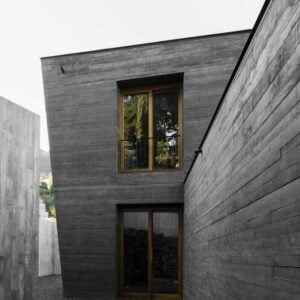In the realm of architecture, materials speak a language of their own. Among them, exposed concrete has emerged as a protagonist, narrating tales of modernity, versatility, and raw beauty. This seemingly cold and impersonal material has been redefined, becoming a canvas for architects and designers worldwide. Let’s delve into the transformative power of exposed concrete and how it’s reshaping the narrative of contemporary home designs.




The Raw Beauty of Simplicity
Exposed concrete, in its essence, is a celebration of rawness and authenticity. Its unrefined texture and neutral palette bring forth an understated elegance that many modern homeowners crave. This material doesn’t try to be something it’s not; it’s genuine, honest, and unapologetically real.
The beauty of exposed concrete lies in its imperfections. Each mark, line, and variation tells a story of its creation, making every wall or surface unique. This character is something that cannot be replicated with other materials, giving homes a distinct identity.
In a world where everything is polished to perfection, there’s a growing appreciation for the imperfect. Exposed concrete, with its blemishes and inconsistencies, stands as a counterpoint to the overly refined, offering a refreshing break from the norm.
This material has a timeless appeal. While trends come and go, the allure of exposed concrete remains constant. Its simplicity serves as a blank canvas, allowing homeowners and designers to imprint their style and personality without overshadowing the material’s innate charm.
Moreover, the tactile experience of exposed concrete is unparalleled. The cool, rough surface under one’s fingertips evokes a sense of connection to the earth, grounding spaces and those within them.


A Canvas for Shadows and Light
The interplay of light and shadow on exposed concrete surfaces is nothing short of magical. As the day progresses, these walls come alive, reflecting and absorbing light in varying intensities, creating a dynamic visual spectacle.
Morning light casts soft, diffused shadows, highlighting the subtle textures of the concrete. As the day advances, these shadows become more pronounced, adding depth and dimension to spaces.
The setting sun paints the walls in warm hues, transforming them into canvases of amber and gold. This daily transformation is a visual treat, making spaces feel alive and ever-evolving.
Architectural features, such as recesses and protrusions in concrete walls, further enhance this play of light and shadow. These design elements, though subtle, can dramatically alter the ambiance of a room based on how they interact with light.
At night, artificial lighting can be used to accentuate the textures and forms of exposed concrete walls. Strategic lighting can create dramatic effects, turning ordinary spaces into artistic installations.


Thermal Efficiency and Sustainability
One of the lesser-known benefits of exposed concrete is its thermal efficiency. Its ability to store and release heat makes it an excellent material for passive temperature regulation, reducing the need for artificial heating or cooling.
During the day, especially in colder climates, concrete walls absorb heat. As temperatures drop at night, this stored heat is gradually released, keeping interiors warm and cozy.
Conversely, in warmer regions, the dense nature of concrete acts as a barrier, preventing external heat from entering homes. This natural insulation ensures interiors remain cool, even during the hottest parts of the day.
Beyond thermal benefits, exposed concrete is sustainable. Its longevity means fewer repairs and replacements, reducing waste. Additionally, using concrete as both structure and finish eliminates the need for additional materials, further minimizing environmental impact.
The production of concrete, when done responsibly, can be eco-friendly. By using recycled aggregates and reducing carbon emissions during manufacturing, the environmental footprint of concrete can be significantly reduced.

Versatility in Design
Exposed concrete is incredibly versatile. While the classic gray hue is iconic, advancements in technology allow for a range of colors and finishes, expanding design possibilities.
Textured finishes, achieved through different casting techniques, can add depth and character to walls. From smooth and polished to rough and rugged, the design options are endless.
Combining concrete with other materials, such as wood or metal, can create stunning contrasts. These juxtapositions highlight the beauty of each material, resulting in spaces that are both harmonious and intriguing.
Concrete isn’t limited to walls. Floors, ceilings, countertops, and even furniture can be crafted from this material, creating a cohesive design language throughout a home.
The moldability of concrete allows for innovative architectural forms. Curves, angles, and unique shapes can be easily achieved, allowing architects and designers to push boundaries and challenge conventions.

A Testament to Durability
Exposed concrete is synonymous with durability. Its robust nature ensures that structures stand the test of time, resisting wear and tear with grace.
Unlike other materials, concrete doesn’t rot, warp, or get infested by pests. This resilience translates to lower maintenance costs and longer lifespans for structures.
Weather elements, be it rain, snow, or sun, have minimal impact on concrete. Its ability to withstand these external factors ensures that homes remain safe and secure, regardless of climatic conditions.
The strength of concrete provides peace of mind. Knowing that a home is built with such a sturdy material offers a sense of security, a sanctuary that’s truly built to last.
Over time, exposed concrete ages beautifully. The patina it develops adds character, making homes feel lived-in and loved, a testament to the memories created within its walls.
Conclusion
Exposed concrete, once seen as merely functional, has emerged as a favorite in the world of modern design. Its blend of beauty, functionality, and sustainability makes it a top choice for contemporary homes. As we look to the future, it’s clear that this material will continue to inspire, shaping the landscapes of our urban habitats.












